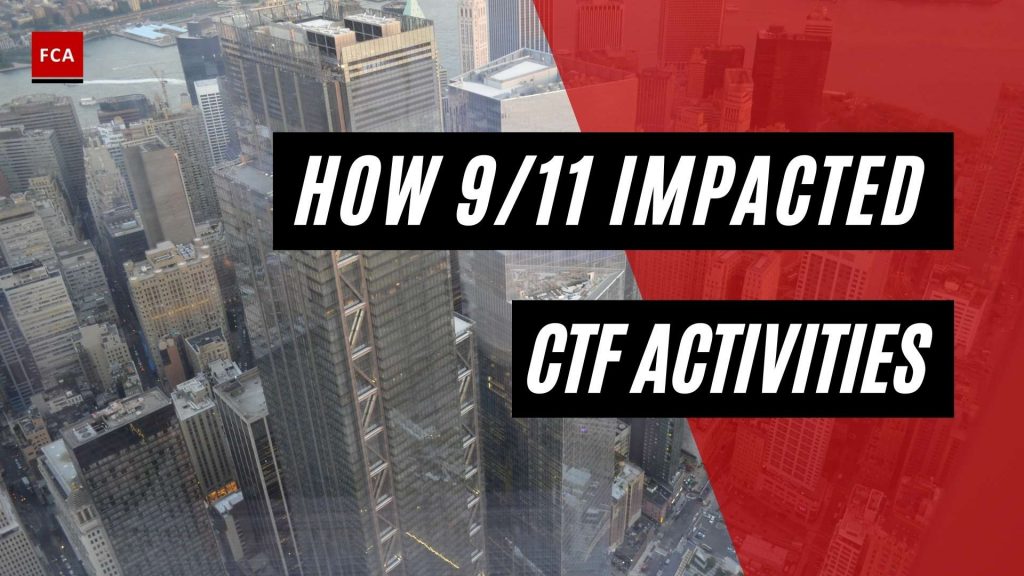CTF was a main focus of law enforcement following the 9/11 attacks. Trailing the sources of funds revealed the blueprints of the terrorist organization. CTF also revealed the vulnerabilities of the international banking system to terrorist organizations and money laundering. This article elaborates on ‘How 9/11 Impacted CTF Activities’.
Among the first steps the United States took on the war on terror following the 9/11 attacks was developing CTF programs. It is worth noting that many of the methods adopted to fight terrorist financing are closely related to those that were initially created for anti-money laundering.

The European Union
In trying to find the scope of terrorist financing, one challenge we face is the definition of terrorism itself. The European Union defines terrorism as acts of terrorism as offences which may “seriously damage a country or an international organization [which are] committed with the aim of: (i) seriously intimidating a population, (ii) unduly compelling a Government or international organization to perform or abstain from performing any act, or (iii) seriously destabilizing or destroying the fundamental political, constitutional, economic or social structures of a country or an international organization.”
The European Union Third Money Laundering Directive defines terrorist financing as “the provision or collection of funds, by any means directly or indirectly, with the intention that they should be used or in the knowledge that they are to be used, in full or in part in order to carry out any of the offences that have been defined as terrorism.”
Critics have argued that the European Union’s definition of acts of terrorism is ambiguous especially when it comes to its interpretation. For example, what would constitute an act that “seriously intimidates a population.”
In the section below, we will discuss the initiatives the European Union has taken to combat terrorist financing. These are divided into policy, regulation, and legislation.
Policy
The European Union has taken a two-tier approach when it comes to counter terrorist financing. On one hand, there is the implementation of financing-freezing measures following the adoption of the United Nations Security Council Resolutions 1276 and 1373. Implementation of these resolutions allows the targeting and sanctioning of individuals or groups that are suspected of providing assistance (including financial) to any terrorist organization.
These measures are complemented by money laundering legislation provided by the European Union’s money laundering regulations and directives on controls of money that is either entering or leaving the European Union and on the personal information of the individual holding and transferring those funds.
Financial Freezing Measures
The United Nations Security Council adopted Resolution 1267/1999 after the al-Qaeda linked terrorist bombings of the American embassies located in Tanzania and Kenya in 1998. The resolution was further extended and modified by Resolutions 1333/2001 and 1390/2000, which established a scheme of freezing funds, economic resources, and other financial assets. Another measure the modified resolutions included are the listing of individuals and organizations affiliated to the Taliban regime of Al-Qaeda and Afghanistan.
The lackluster results of Resolution 1267/1999 to extradite Osama Bin Laden and further neutralize Al-Qaeda’s activities together with the 9/11 attacks invigorated the United Nations Security Council to pass Resolution 1373/2001. The key difference between the two resolutions is that the latter provided the UN Member States the option of establishing an autonomous list of suspects, subject only to scrutiny by the Security Council Counter-Terrorism Committee. Resolution 1373 further extended the definition of terrorists beyond individuals and groups linked to Al-Qaeda and the Taliban and encompassed all terrorist suspects.
Following the passage of this resolution, the European Union incorporated measures that provided the legal basis for listing terrorist suspects, freezing of assets related to terrorist activity and terrorist organizations, and permitting police and the judiciary to cooperate to prevent acts of terrorism.
The European Union has further used its global influence to incorporate a counter-terrorism clause in its current and new development assistance agreements and instruments with third countries. The clause permits cooperation with third countries in the prevention and suppression of acts of terrorism either by exchanging information, know-how, or experiences based on the framework of Resolution 1373/2001.
The new mechanism set out a significant change in the European Union’s position and role in counter terrorist financing. Up until 2001, the European Union had mainly relied on the traditional framework of legislation, and Member States were to implement the legislation individually. The balance also shifted from placing standards for the legal fight against terrorism to taking measures that are close to enforcement.

Money Laundering Legislation
The third approach the European Union incorporated to counter the financing of terrorism has its origins in anti-money laundering legislation. The measures mainly focus on precautionary actions rather than a more proactive approach of listing terrorist suspects and freezing their financial assets.
The establishment of the Financial Action Task Force (FATF) was the most noteworthy impetus that led to legislative action against money laundering. The Financial Action Task Force was established in 1989 by the G-7 Summit in Paris, France with the objective of coordinating an international response to the problem of money laundering.
Among the first tasks that the Financial Action Task Force (FATF) set were the 40 Recommendations that set out an effective framework for anti-money laundering. Since 9/11, the standard setting from the recommendations has garnered increased significance. In 2004, the FATF further proposed nine other special recommendations to limit the prospects of terrorist syndicates using the international financial system to transfer funds meant to support acts of terrorism.
The first and second Money Laundering Directives (MLD) were approved in 1991 and 2001 respectively. The first MLD (1991) imposed anti-money laundering obligations on credit and financial institutions while the second MLD (2001) imposed anti-money laundering obligations on Designated Non-Financial Professional Bodies (DNFPBs) including lawyers, accountants, notaries, casinos, real estate agents, and dealers in goods of high value.
The second MLD (2001) subjected these professional bodies to various obligations including record keeping, customer identification, and reporting of suspicious transactions. The directive also directed Member States to form Financial Intelligence Units or FIUs in short that would be responsible for receiving, analyzing, and transmitting reports on suspicious transactions to the competent law enforcement authorities.
While the first anti-money laundering initiatives mainly focused on profits generated from drug trafficking, the third MLD broadened in scope and targets any funds generated through criminal activity.
Adopted in 2005, the third MLD was the first legislation that sought to address CTF. In addition to the nine special recommendations against terrorist financing, the legislation also incorporated the majority of the reviewed 40 FATF recommendations and the nine special recommendations against terrorist financing. The directive further encompassed the oversight regime encompassing the financial sector and Designated Non-Financial Professional Bodies. Further, the directive extended the scope of offences to include tax fraud and encouraged financial intelligence units to work together more effectively.
Final Thoughts
After the 9/11 attack, law enforcements put their efforts and focus on CTF. Tacking the trail and sources of funds revealed the blueprints of the terrorist organization. CTF also helped reveal the vulnerabilities of the international banking system to terrorist organizations and money laundering. This article elaborates on ‘How 9/11 Impacted CTF Activities’.









